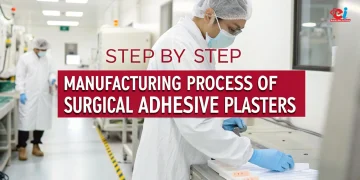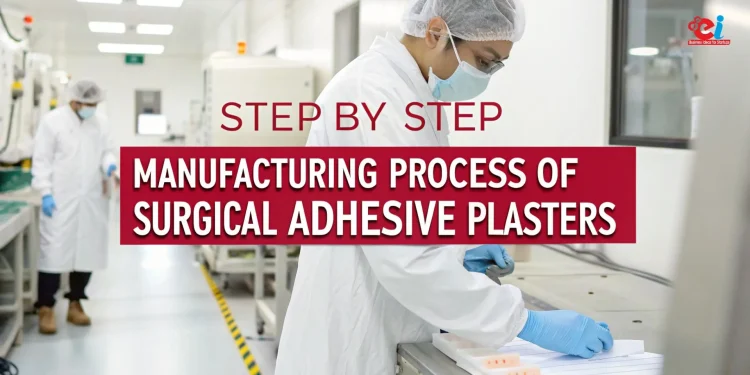Demand for surgical adhesive plaster both in India as well as around the world has steadily increased because of the expanding healthcare infrastructure, a greater knowledge of sanitation, and an increasing population that requires medical attention. The surgical adhesive plaster, ranging from simple wound care strips to specialized hypoallergenic versions, is used in clinics, hospitals, as well as in private homes. Therefore, creating an industrial manufacturing facility is a viable business opportunity for entrepreneurs wanting to get into the healthcare consumables business.
This article explains the entire process of manufacturing surgical adhesive plasters in a logical and simple format that is easy to comprehend. This is a great resource for entrepreneurs, medical device manufacturers, or companies looking to enter this crucial sector of the healthcare business.
Understanding What Surgical Adhesive Plaster Is
The sterile surgical adhesive plaster are ready-to-use items that are designed to help heal injuries, hold dressings for surgery in place, and secure medical devices such as IVs and catheters onto the skin. They typically comprise of three primary components comprising an adhesive covering fabric (often either plastic or cotton) and an adhesive (usually made of silicone rubber or zinc oxide) as well as a liner that helps ensure the integrity of the adhesive before application.
Plasters are believed to be non-toxic, safe for the skin and breathable. They should also be strong enough to stay put for long periods of time. The increasing emphasis on the prevention of infection in hospital hygiene, managing chronic diseases has expanded the use of this product to include the government healthcare departments as well as private hospital as well as pharmacies.
Related: A Feasibility Guide to Launching a Profitable Medical Device Manufacturing Startup in India
Overview of the Manufacturing Process
The manufacturing of surgical adhesive plasters has many interconnected stages, from the preparation of raw materials to the packaging. Each step has to be completed in clean and safe conditions in order to ensure medical-grade standards and regulatory compliance.
Let’s go through each step in detail:
1. Selection and Preparation of Raw Materials
The process starts by selecting the finest raw materials. The main components are the material used for backing (such as woven cotton fabric, non-woven material and PVC films) and the pressure-sensitive adhesive, as well as an release liner.
The material used for backing is typically pre-treated to make it supple and breathable. It’s also suitable for use in medical settings. It is bleached, scoured or sterilized, depending on the intended use. The adhesive is made in a controlled atmosphere by using a mix of medical-grade ingredients like aluminum oxide and rubber-based compound, and acrylic emulsions. These adhesives have been specially designed to be non-irritant for skin and provide the strongest yet non-irritating bond.
2. Adhesive Application on the Backing Substrate
When the base fabric, or film is ready it goes by a coater unit in which the adhesive is evenly applied over its entire surface. This is a crucial step in the process because consistency in thickness of coating is essential to the effectiveness of the plaster.
There are typically two types of coating methods used in industrial settings–knife-over-roll coating or gravure coating. The coated material is then moved into a tunnel for drying which aids in the removal of water or solvent from the adhesive. Drying must take place in the right temperature ranges to ensure the quality of the adhesive without causing damage to or damaging the material backing it.
3. Laminating using Release Paper
When the coating on the adhesive has dried, the release paper, coated with silicone, is laid on the surface of the adhesive to prevent it from adhering to unwelcome surfaces during transport or handling. The release liner helps protect it from being damaged until the finished product is removed and then applied to the skin.
The process of laminating is generally executed by a continuous web. The accuracy of alignment and even adhesion between the release liner and the adhesive layer is essential, since any deviation could affect the quality of the final product.
4. Slitting and Cutting
After being laminated, the large pieces of plaster are cut in smaller pieces or cut into separate strips based on the final product’s size and shape. For roll-type adhesive plasters, high-precision slitting equipment is used to transform the master roll into medical-grade rolls with various dimensions (usually from 1cm to 10 cm).
For plasters that are bandage-like, automated machines are used, equipped with die-cutting and punching equipment to cut out designs, often with rounded edges. They also ensure uniformity in size, shape, and edge sealing, which is essential to ensure sterility of the product and user-friendliness.
5. Sterilization (If Required)
Many surgical plasters, which are medical-grade, undergo sterilization to ensure they are safe for direct use on wounds. This can be accomplished using the ethylene oxide (ETO) gas sterilization or gamma radiation, depending on the product’s specifications and the regulatory requirements.
The sterilization process must be carried out in compliance with medical device specifications like ISO 11135 or ISO 13485. After sterilization, the product is evaluated for sterility and adhesion, tensile strength and biocompatibility, to ensure that it complies with the necessary safety standards.
6. Inspection and Quality Control
A strict quality control system is crucial at each step of the manufacturing process. Quality assurance teams check for any defects, like adhesive irregularities and poor lamination, inadequate sealing or contamination. Tests are also carried out on random samples to determine properties such as peel strength and water vapor transmission, stretching ability and cytotoxicity.
The compliance with Indian Pharmacopoeia (IP), US Pharmacopeia (USP), or CE certifications is usually required for units that export.
7. Primary and Secondary Packaging
The final stage is packaging the plasters in sterilized pouches or blisters by using automated packaging equipment. The primary packs are wrapped in shrink-wrapped cartons or units that are suitable for retail or hospital supplies.
Each package is marked with information like the type of product and batch number, as well as the production date, the expiry date, as well as the usage guidelines. The integration of barcodes, tamper-proof seals, recycling packaging, and tamper-proof sealing is frequently designed to meet both consumer and regulatory requirements.
Market Forecast and Sector Growth
The market worldwide for the use of plasters with surgical adhesives are anticipated to expand at a rate of more than 5% over the 2024-2029 timeframe. In India, this market is growing rapidly because of the increasing spending on health care as well as the growth of health centers that are run by the government (PHCs) and the growing increasing demand from markets in rural areas for inexpensive but efficient medical equipment.
According to recent survey of industry according to recent industry surveys, the Indian market for wound-care products, including tapes, adhesive bandages and surgical plasters — is expected to surpass the value of Rs5,000 crore by 2028. Factors like Pradhan Mantri Jan Arogya Yojana (PM-JAY), Ayushman Bharat and the growing demand for medical tourism are also factors that accelerate the market’s rise.
With a strong concentration on local production under the Make in India initiative, many institutions, military and paramedics also source from Indian MSMEs which is opening substantial B2B possibilities.
Related: How to Start a Surgical Adhesive Plaster Manufacturing Business
Sustainability and Innovation in Manufacturing
The market for surgical adhesives is also adjusting to newer methods and materials, as well as greener methods. Biodegradable and skin-safe hydrocolloid adhesives, as well as eco-friendly packaging are currently being researched. Automation is also helping improve quality and efficiency while reducing the amount of waste.
Companies that invest in high-quality coating equipment and sterile handling facilities as well as quality control systems will be more placed to expand their operations and export to international markets.
For more information, check out this video
How NPCS Can Help You Start This Business
Niir Project Consultancy Services (NPCS) provides comprehensive assistance to entrepreneurs who want to join the manufacturing of surgical adhesive industry. NPCS produces Market Surveys and detailed Technoeconomic Feasibility Reports that provide information on demand for the market as well as scope and viability.
The reports they provide contain specific manufacturing procedures, lists of raw materials, and plant layout plans as well as estimates of financials aiding new companies to make informed choices. With over a decade of expertise, NPCS also assists in making assessments of the commercial and technical potential for industrial ventures in India as well as abroad.
Which business to start? How to choose a business idea?
Final Thoughts
The manufacturing process for surgical adhesive plasters requires an exact mix of precision in technology as well as quality control and hygiene conformance. The preparation of the raw material to the sterilized packaging step must be carried out within strict medical-grade standards.
With India’s growing healthcare requirements and a favorable industrial climate, entrepreneurs and startups are in a prime position to help improve the nation’s healthcare infrastructure and build an efficient and sustainable manufacturing enterprise.
If you’re looking to enter this industry, knowing the industry’s manufacturing process and the dynamics is the first step. The next step? Get expert advice. The NPCS team is ready to help.


















